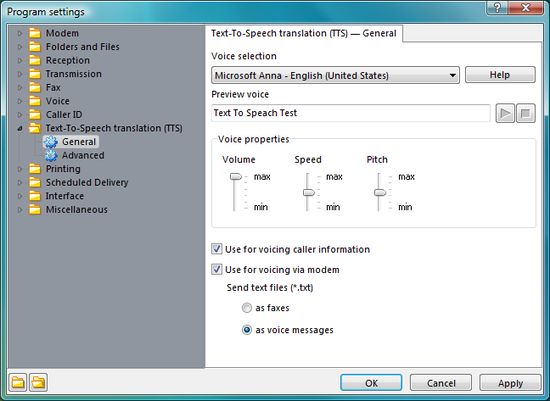|
The program can play both pre-prepared sound files (*.WAV) and text
files (*.TXT or *.MIX), via the modem in the telephone line or the computer's
sound device. In the latter case what is known as 'text-to-speech' (TTS)
translation takes place. The translation is performed by a TTS engine
that must be installed independently of the program. After the engine
is installed, one or more TTS Voices appear in the system, as 'Microsoft
Sam' for example. VentaFax supports SAPI version 4 and 5.1 engines.
The standard Windows XP package includes the SAPI version 5.1 engine
(English language only). Version 4 engines can be downloaded from the
Microsoft web site:
SAPI 4 programming interface: http://www.microsoft.com/msagent/downloads/user.asp#sapi
Various engines: http://www.microsoft.com/msagent/downloads/user.asp#tts
Other companies also provide TTS engines.
Enabling the TTS mode
Open the Text-To-Speech Translation (TTS) - General tab. If
speech engines (voices) have been installed in the system, they will
appear in the Voice selection drop-down list. Select the voice
you wish to use.

Playing back caller information
After a caller's phone number is delivered (by means of Caller ID),
it can be played back via the computer's sound device. The Voicing
number via sound device setting under the Caller ID - Displaying
and Voicing tab must be enabled for this purpose. When using TTS,
certain other information about the caller (in addition to his or her
phone number) can also be reproduced. The program searches for the delivered
phone number in all available phonebooks. If the search is successful,
the caller's name and/or the contents of the phonebook's Comment
field can be played back.
In order to use TTS for playing back caller information, check the Use
for voicing caller information box under the Text-To-Speech Translation
(TTS) - General tab. By default, the caller's delivered phone number
and name - if the number is found in one of the phonebooks - are reproduced.
The information to be played back can be customized. To do so, open
the Text-To-Speech Translation (TTS) - Advanced tab. The Caller
information field can contain variables that specify what exactly
will be played.
Before the phone number is given, the text from the Number field
is played back. In the event the caller's number is not delivered, the
text from the Not-delivered field is played back.
Using TTS for voicing via modem
With TTS, all announcements to be played back in the telephone line,
such as the answering machine greeting message, can be specified by
text files (*.TXT). Check the Use for voicing via modem setting
under the Text-To-Speech Translation (TTS) - General tab. To
select a text announcement, open the Folders and Files - Service
Files tab, and select the desired announcement files. Selected announcements
can be played back and edited, if necessary, in the same tab.
In addition, a text file can be transmitted as a voice message, including
a scheduled delivery option. To prevent the text file from being converted
to facsimile format, enable the Send text files (*.txt) as voice
messages setting under the Text-To-Speech Translation (TTS) -
General tab.
Special text files (*.MIX)
Files with an *.MIX extension are treated differently by the program.
These files may contain both text lines and links to both text (*.TXT)
and sound (*.WAV) files. Text lines must be placed in double quotation
marks (e.g., "text line"). If file names do not contain the
full path, it is assumed they are located in the same folder as the
*.MIX file. Text lines can also contain variables. This version of VentaFax
does not support TTS text file playback in the remote control scripts.
Playing back answering machine remote control phrases
You can also redefine some phrases used in an answering machine remote
control session, under the Text-To-Speech Translation (TTS) - Advanced
tab. These phrases are used when the PLAY_REP_INFO X operation is performed.
In addition, the Extended information setting can contain several
variables that specify which data are to be played back for various
answering machine playback operations if the settings of these operations
[PA] are not set to zero.
|